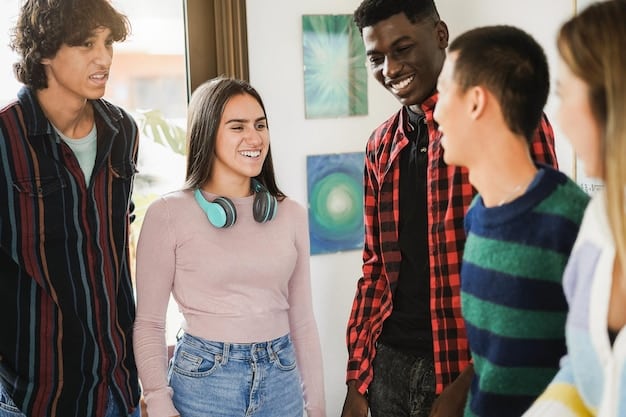Gen Z’s Collaborative Learning Impact on Social & Cognitive Growth

Collaborative learning profoundly shapes Gen Z’s social and cognitive development by fostering critical soft skills such as communication, problem-solving, and empathy, while simultaneously enhancing academic achievement through shared knowledge construction and diverse perspectives, preparing them for future success in an interconnected world.
In today’s rapidly evolving educational landscape, understanding how collaborative learning impacts Gen Z’s social and cognitive development is more crucial than ever. This generation, often characterized by its digital fluency and a strong desire for connection, thrives in environments that encourage interaction and shared discovery. Collaborative learning strategies offer a powerful antidote to traditional, passive teaching methods, providing a dynamic space where young minds can flourish socially and intellectually.
Understanding Gen Z: Digital Natives and Social Learners
Gen Z, born roughly between 1997 and 2012, has never known a world without the internet. This omnipresence of digital technology profoundly shapes their learning preferences and social interactions. Unlike previous generations, they are often self-directed learners, adept at quickly finding information, and naturally inclined towards multitasking. However, this digital fluency also presents unique challenges, particularly in developing deeper social and emotional intelligence.
Their native digital environment means Gen Z is accustomed to instant feedback, constant connectivity, and a vast array of information at their fingertips. This comfort with technology translates into an expectation of dynamic and interactive learning experiences. Traditional lectures may feel outdated, while collaborative projects, online discussions, and peer-to-peer teaching align more closely with their intrinsic habits and expectations. Their social interactions, though often mediated by screens, still emphasize community and belonging, making collaborative structures particularly appealing and effective.
The Shift in Learning Paradigms
The transition from individualistic, teacher-centric models to more collaborative, student-centric approaches isn’t just a trend; it’s a response to the changing needs of learners. Educational institutions are increasingly recognizing that to prepare Gen Z for a complex future workforce, they must cultivate skills beyond rote memorization.
- Active Engagement: Collaborative learning demands active participation, moving students from passive recipients to active contributors.
- Personalized Learning: Group work can be tailored to various learning styles, accommodating diverse needs within a single activity.
- Real-world Relevance: Many professional settings require teamwork, making collaborative learning a practical preparation for future careers.
For Gen Z, who are often pragmatic and value authenticity, this relevance is a significant motivator. They want to see how what they learn connects to real life, and collaborative projects often provide that direct link, allowing them to apply knowledge in meaningful contexts.
This generation also places a high value on diversity and inclusivity, often advocating for social justice and equity. Collaborative learning environments, when designed effectively, naturally promote these values by bringing together individuals with different backgrounds, perspectives, and skills. This exposure to diverse viewpoints enriches the learning experience and broadens their understanding of complex issues.
Cognitive Development: Beyond Rote Memorization
Collaborative learning extends far beyond social benefits, significantly impacting cognitive development. When Gen Z students engage in group projects, discussions, and problem-solving activities, they are not merely sharing answers; they are actively constructing knowledge together. This process strengthens higher-order thinking skills that are essential in critical analysis and innovation.
Working in teams compels students to articulate their thoughts, defend their reasoning, and assimilate new information presented by peers. This active processing of information deepens understanding and retention, as opposed to passively listening to a lecture or reading a textbook. The act of teaching a concept to someone else, for instance, solidifies one’s own comprehension. This engagement promotes metacognition, where students reflect on their own thinking processes, identifying strengths and areas for improvement.
Deepening Understanding Through Shared Inquiry
When students collaborate, they are exposed to multiple perspectives and problem-solving approaches. This cognitive friction can be incredibly productive, challenging preconceived notions and leading to a more nuanced understanding of complex topics. Instead of a single, authoritative voice, they encounter a chorus of ideas, requiring them to critically evaluate, synthesize, and integrate different viewpoints.
- Enhanced Problem-Solving: Complex problems often benefit from varied insights, leading to more robust and creative solutions.
- Critical Thinking: Students learn to analyze arguments, identify biases, and evaluate the credibility of information from their peers.
- Knowledge Construction: Rather than receiving knowledge, students actively build it, making the learning process more meaningful and lasting.
This dynamic learning environment also trains their brains to adapt. Gen Z thrives in fast-paced, information-rich environments, and collaborative tasks simulate this by requiring them to quickly process shared information and react in real-time discussions. This cognitive agility is a direct benefit of consistent collaborative practice.
Moreover, the process of clarifying one’s own thoughts to explain them to a group acts as a powerful cognitive amplifier. It forces students to organize their ideas logically and identify any gaps in their understanding. This self-correction mechanism naturally occurs in functional collaborative settings, leading to more robust individual learning outcomes that transcend mere memorization.
Social Development: Cultivating Essential Life Skills
The social dimensions of collaborative learning are arguably as important as the cognitive ones, particularly for Gen Z, who often navigate a paradox of hyper-connectivity and potential social isolation. Collaborative environments provide invaluable opportunities to develop crucial interpersonal skills that are vital for both academic and professional success.
Interacting with peers in a goal-oriented setting requires effective communication, active listening, and negotiation. Students learn to express their ideas clearly, provide constructive feedback, and respectfully disagree. These aren’t skills that can be taught solely through textbooks; they are cultivated through direct, repeated experience in social contexts. This generation already values community and connection, and collaborative learning taps directly into this innate desire, providing a structured, purposeful way to build those valuable connections. It moves beyond superficial online interactions to genuine, face-to-face (or synchronous online) collaboration, which fosters deeper understanding of social cues and dynamics.

Building Empathy and Inclusivity
One of the profound social impacts of collaborative learning is the development of empathy. When students work together, they are exposed to diverse perspectives, backgrounds, and working styles. This exposure challenges their own viewpoints and encourages them to understand and appreciate differing opinions.
- Perspective-Taking: Understanding why a peer holds a certain view, even if different from one’s own, builds empathy.
- Conflict Resolution: Group projects often involve disagreements, providing safe environments to practice negotiation and compromise.
- Respect for Diversity: Working with individuals from various backgrounds fosters an inclusive mindset and appreciation for different contributions.
These skills are not just “nice-to-haves”; they are fundamental for navigating an increasingly globalized and diverse world. For Gen Z, who are often keenly aware of social issues, collaborative learning can reinforce their values of equity and mutual respect, translating abstract concepts into lived experiences. The act of supporting a peer, or being supported, creates bonds and a sense of shared responsibility, which are cornerstones of a healthy social fabric.
Furthermore, leadership skills naturally emerge and are refined in collaborative settings. Students learn when to lead, when to follow, and how to delegate tasks effectively. They also develop accountability, understanding that their individual effort contributes to the group’s overall success or failure. This sense of collective responsibility is a powerful motivator for Gen Z, aligning with their desire to make an impact and contribute to something larger than themselves. The structured nature of collaborative tasks can help them channel their digital connectivity into meaningful, real-world social engagement.
Challenges and Strategies for Effective Implementation
While the benefits of collaborative learning are extensive, its effective implementation requires careful planning and execution, especially when working with Gen Z. One of the primary challenges is ensuring equitable participation. Some students may dominate discussions, while others might withdraw, feeling intimidated or less confident in a group setting. It is essential to create an environment where every voice is valued and heard.
Another challenge stems from Gen Z’s reliance on digital tools. While they are adept at using technology, translating individual digital proficiency into effective digital collaboration requires specific scaffolding. Issues like digital distractions, coordination of online tools, and ensuring productive virtual collaboration need to be addressed. Educators must guide students not only in what to collaborate on, but also how to effectively collaborate using the tools they are familiar with.
Mitigating Common Roadblocks
To maximize the impact of collaborative learning, educators can employ several strategic approaches to mitigate these potential roadblocks and ensure the process benefits all students in Gen Z.
- Clear Roles and Expectations: Assigning specific roles (e.g., facilitator, note-taker, presenter, timekeeper) ensures all members contribute and take ownership.
- Structured Group Formations: Strategically forming groups based on diverse skill sets, learning styles, or even social dynamics can lead to more balanced and productive interactions.
- Regular Check-ins and Feedback: Providing opportunities for groups to report progress and receive constructive feedback helps keep them on track and addresses issues early.
- Teaching Collaboration Skills: Explicitly instructing students on communication, conflict resolution, and active listening prepares them for successful group work.
Technology can also be an ally. Utilizing collaborative platforms (like shared documents, project management tools, or video conferencing) that Gen Z frequently uses can streamline workflows and facilitate communication. These tools, when used thoughtfully, can bridge geographical distances and allow for flexible working schedules, catering to the diverse needs and preferred modalities of this generation. Moreover, using technology for collaborative learning provides Gen Z with crucial digital literacy skills for the workplace, where virtual teams are increasingly common.
Addressing potential group dynamics by rotating roles within a project or across multiple projects can also help prevent any single student from consistently dominating or receding. This ensures that every individual has the opportunity to experience leadership and followership, building a more well-rounded skill set. Educators should also consider incorporating peer assessment, allowing students to reflect on their own contributions and the contributions of their teammates, fostering a sense of individual and collective accountability within the group framework.
The Role of Technology in Collaborative Learning for Gen Z
For Gen Z, technology is not merely a tool; it is an extension of their reality. Integrating digital tools into collaborative learning environments is therefore not an option, but a necessity to resonate with their learning styles and capitalize on their inherent digital fluency. Properly leveraged, technology can amplify the reach and effectiveness of collaborative learning, creating dynamic and responsive environments that mimic real-world professional settings.
Online discussion forums, shared cloud documents, video conferencing platforms, and project management software enable students to collaborate asynchronously and synchronously, transcending physical classroom boundaries. This flexibility caters to Gen Z’s preference for on-demand access and personalized learning pathways. It also allows for continuous engagement, as students can contribute to discussions or edit documents outside of scheduled class times, whenever inspiration strikes or their schedule permits.
Leveraging Digital Tools for Enhanced Collaboration
The strategic incorporation of technology transforms how Gen Z collaborates, enriching both their social and cognitive development:
- Enhanced Communication: Tools such as Slack or Discord create dedicated channels for group communication, fostering continuous dialogue and quick problem-solving.
- Shared Creation: Platforms like Google Docs or Microsoft 365 allow for real-time co-creation and editing, teaching students to merge ideas seamlessly.
- Virtual Meeting Spaces: Zoom or Teams facilitate face-to-face interactions for remote learners or for groups to meet outside campus hours, promoting a sense of collective presence.
- Resource Sharing: Digital libraries and curated online resources can be easily shared and annotated within groups, augmenting the depth of research and analysis.
Crucially, technology helps formalize the collaboration process, providing digital records of contributions that can be reviewed and assessed, promoting accountability. For a generation accustomed to transparent digital footprints, this appeals to their sense of fairness and merit. It also enables educators to monitor group progress more effectively, intervening when necessary to guide collaboration or mediate conflicts. The ability to quickly share diverse media types—from videos to infographics—enriches projects, allowing Gen Z to explore modalities beyond traditional text, fostering creativity and digital communication skills.
However, educators must consciously guide students in using these tools productively. The inherent distractions of digital environments necessitate teaching digital citizenship and focusing skills. Establishing clear guidelines for online interaction, managing notifications, and ensuring equitable participation across digital platforms are paramount. This involves not just facilitating access to tools, but also teaching the etiquette and strategies for effective digital collaboration to ensure that technology serves as an enabler, not a detractor, in their learning journey.
Measuring the Impact: Assessment and Feedback
Assessing collaborative learning outcomes requires a departure from traditional individualistic evaluation methods. For Gen Z, who value transparency and clear expectations, the assessment framework must reflect the multifaceted nature of teamwork, encompassing both individual contributions and collective achievements. This approach encourages productive engagement and reinforces the value of both social and cognitive gains.
Effective assessment goes beyond grading the final product; it evaluates the process of collaboration itself. This can involve observing group dynamics, analyzing communication logs on digital platforms, and incorporating peer evaluations. Such comprehensive assessment provides a clearer picture of each student’s development, highlighting areas of strength and identifying opportunities for growth in social and cognitive skills.
Comprehensive Evaluation Strategies
To accurately measure the impact of collaborative learning on Gen Z, educators can employ a variety of assessment and feedback strategies:
- Rubrics for Collaboration: Develop clear rubrics that define successful collaborative behaviors (e.g., active listening, constructive feedback, equitable sharing of workload).
- Peer and Self-Assessment: Encourage students to evaluate their own contributions and those of their peers, fostering reflection and accountability.
- Process Journals: Students can maintain journals documenting their collaborative journey, reflecting on challenges, breakthroughs, and learned skills.
- Instructor Observation: Direct observation of group interactions provides qualitative data on communication, problem-solving, and conflict resolution skills.
Providing timely and constructive feedback is particularly important for Gen Z, who thrive on immediate and actionable insights. This feedback should not only address academic content but also explicitly comment on effective collaboration strategies and areas for social development. For instance, feedback might highlight successful negotiation during a disagreement or commend a student for effectively clarifying a complex concept to a peer. This reinforces the idea that the process of how they learn is as important as what they learn, aligning with their desire for personal growth and practical skill development.
Moreover, the use of digital tools can facilitate continuous feedback loops. Online platforms can track individual contributions to shared documents, participation in forums, and completion of assigned roles. This data can be used by both instructors and students to understand engagement levels and refine collaborative strategies in real-time. For Gen Z, who are accustomed to data-driven insights and personalized feedback from their digital interactions, this provides a familiar and effective way to monitor and improve their collaborative performance. Ultimately, a robust assessment framework validates the effort invested in collaborative learning and explicitly links it to tangible improvements in their social and cognitive abilities.
Preparing Gen Z for the Future Workforce
The skills cultivated through collaborative learning are not merely academic; they are the bedrock of success in the modern workforce, particularly for Gen Z. Employers consistently rank teamwork, communication, and problem-solving as top attributes for new hires. Traditional individualized learning often falls short in developing these crucial “soft skills.” Collaborative learning bridges this gap, providing a simulated professional environment where these competencies can be honed.
The future workforce will increasingly rely on cross-functional teams, remote collaboration, and adaptive problem-solving—scenarios that collaborative learning actively prepares Gen Z for. Graduates who have mastered the art of group dynamics, can articulate complex ideas effectively, and contribute meaningfully to collective goals will possess a distinct advantage in a competitive job market. This practical application of skills is especially appealing to Gen Z, who often seek purpose and applicability in their educational journey.
Essential Skills for a Dynamic Future
Collaborative learning equips Gen Z with a toolkit of essential skills, making them highly adaptable and valuable contributors in diverse professional settings.
- Teamwork and Collaboration: Experience in shared projects, task delegation, and mutual support directly translates to workplace efficiency.
- Communication Proficiency: Learning to articulate ideas, listen actively, and provide constructive feedback is fundamental for professional interactions.
- Adaptive Problem-Solving: Tackling complex challenges in groups fosters creativity and the ability to find innovative solutions under pressure.
- Digital Acumen: Using collaborative technologies for group projects enhances their proficiency with tools common in remote and hybrid work environments.
- Interpersonal Empathy: Understanding different perspectives and working styles is vital for building strong professional relationships and navigating diverse teams.

This generation will enter a world where innovation is often a collective effort, and the ability to integrate diverse talents and ideas is paramount. Collaborative learning instills the confidence and competence to thrive in such environments, moving beyond individual achievements to appreciate and foster collective success. It teaches them that their individual brilliance is amplified when combined with the strengths of others.
Moreover, the iterative nature of collaborative projects, with their cycles of planning, execution, feedback, and revision, mirrors the agile methodologies prevalent in many industries. This exposure to project-based learning within a collaborative framework provides Gen Z with a foundational understanding of project management principles and resilience—qualities highly sought after by employers. Ultimately, effective collaborative learning transforms the educational experience from mere information transfer into a holistic development process, preparing Gen Z not just for jobs, but for meaningful and impactful careers in an ever-changing world.
| Key Aspect | Brief Description |
|---|---|
| 💡 Cognitive Growth | Enhances critical thinking, problem-solving, and deepens understanding through shared inquiry. |
| 🤝 Social Skills | Develops communication, empathy, conflict resolution, and teamwork abilities crucial for life. |
| 📱 Tech Integration | Leverages digital tools for seamless collaboration, mirroring modern workplace practices. |
| 🚀 Future Readiness | Prepares Gen Z for the collaborative, dynamic demands of the 21st-century workforce. |
Frequently Asked Questions About Collaborative Learning and Gen Z
Collaborative learning involves students working together in groups to achieve a common learning goal. It is highly relevant for Gen Z because as digital natives, they thrive on interaction, connectivity, and practical application. This method aligns with their inherent desire for social engagement and leverages their familiarity with digital tools to foster deeper cognitive and social skill development.
Collaborative learning boosts cognitive development by encouraging critical thinking, problem-solving, and knowledge construction. When Gen Z students articulate ideas to peers, defend reasoning, and integrate diverse perspectives, they deepen their understanding, improve retention, and develop higher-order thinking skills through active engagement rather than passive reception.
Collaborative learning is instrumental in developing crucial social skills for Gen Z, including effective communication, active listening, empathy, and conflict resolution. Through group interactions, students learn to express ideas respectfully, understand diverse viewpoints, negotiate differences, and take collective responsibility, which are essential for interpersonal relationships and teamwork.
Key challenges include ensuring equitable participation among all students, managing potential digital distractions, and effectively integrating technology into collaborative workflows. Educators must provide clear structure, assign roles, teach explicit collaboration skills, and monitor group dynamics to overcome these hurdles and maximize the benefits for Gen Z learners.
Collaborative learning builds essential workforce skills such as teamwork, communication, adaptive problem-solving, and digital acumen. It mimics real-world professional environments, teaching Gen Z to contribute to collective goals, manage projects, and navigate diverse team dynamics. These competencies are highly valued by employers and are critical for success in an increasingly interconnected and collaborative global economy.
Conclusion
Collaborative learning stands as a cornerstone in the educational framework designed to support Gen Z’s holistic development. By actively engaging this digitally-native generation in structured group activities, educators not only foster profound cognitive growth, but also hone crucial social skills such as empathy, communication, and problem-solving. This approach moves beyond traditional memorization, empowering students to construct knowledge together, negotiate diverse perspectives, and adapt to rapidly changing information landscapes. The integration of technology, a natural extension of Gen Z’s environment, further enhances these collaborative experiences, preparing them not just for higher academia, but for dynamic and interconnected professional lives. Ultimately, investing in collaborative learning is an investment in Gen Z’s future workforce readiness and social aptitude, equipping them with the essential tools to thrive as innovative and empathetic global citizens.





